Chimney pipe: how to insulate it properly
After the stove is folded and the pipe is installed, it's time to think about how to insulate the chimney pipe. This will allow you to protect the roof from leaks, and the house itself, from fire. It will be very useful to think about the insulation at the design stage of the building, because in this case, you can achieve reliable and safe insulation. If we are talking about the already erected chimney, the procedure may entail changes in the design of the roof and floors.
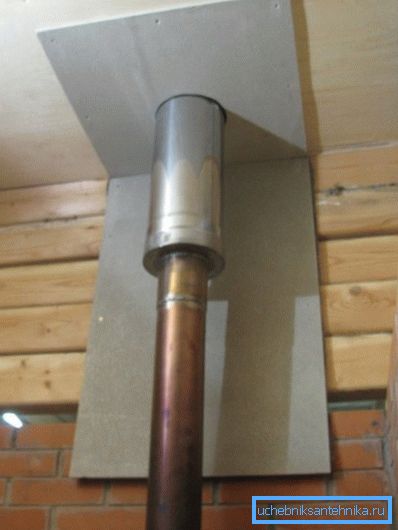
Why insulation is needed
Heat and waterproofing of the chimney is carried out for several reasons:
- Pressure drops that occur in the chimney constantly. Traction in pipes is not the same, because the heating element is not able to maintain a stable level of pressure.
- Temperature drops.
- High humidity. Weather conditions largely determine the level of humidity, which can have significant differences.
- Wind. Strong gusts of wind can adversely affect the life of the chimney, because the design must be strong.
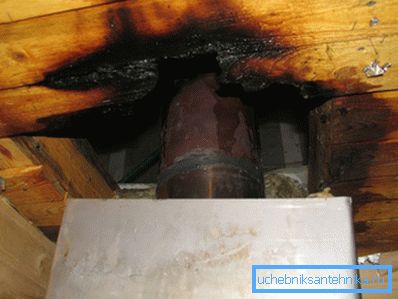
What is important to know before isolation
Before you determine how to wind the metal chimney pipe, you must make sure that the design meets the following standards:
- In order to ensure good traction, the height of the chimney pipe must be at least 5 meters.
- In that case, if the roof is made of combustible materials, such as ondulin, slate or roofing felt, then it is necessary to install spark pipes in the top of the pipe, which is a metal grid with small cells.
- There should be a distance of at least 250 mm between the pipe and combustible structures, such as floors and truss system.
- If we are talking about a brick chimney, in places where it passes through the ceiling, it is necessary to perform a pipe thickening - a fuzzy, one and a half and a half bricks thick.
Insulation Methods

In modern homes, two types of pipes are usually installed:
- Brick.
- Metallic.
And the method of isolation depends on the material of the pipe.
| Material | Isolation method |
| Brick | Since the outer side of such chimneys does not heat up very much, the issue of insulation only concerns improving performance and extending service life. The most rational way is plastering with a cement-known or cement mortar. In addition, the price of such works is more than acceptable. |
| Metallic | For chimney pipes made of metal, it is best to make sandwich constructions. They allow you to improve heat saving and protect the chimney from moisture and temperature extremes. |
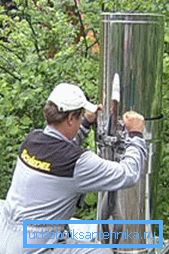
Brick plastering
For the work you need:
- Cement - 25 kN.
- Slaked lime - 2 buckets.
- Sand or its mix with a slag crumb.
- Water - 5 buckets.
Plastering is done in several stages.
This will help you the following instructions:
- Prepare the solution by mixing cement with four buckets of water. In this mixture, add two buckets of hydrated lime and mix thoroughly. After that, sand and slag dust are added to the mixture, after which the remaining water is poured.
Note! The resulting composition is used for 5 hours in cool weather. In the heat, it should be used within two hours, so it is more rational to cook it in parts.
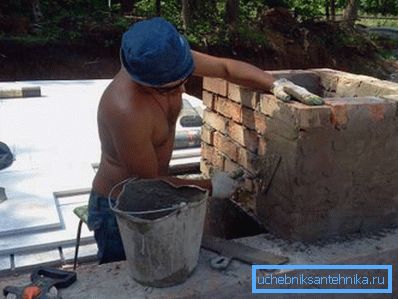
- If the surface of the chimney has large irregularities, then the plaster has to be applied with a thick layer. Therefore, it is better to pre-fill all the cracks with plaster, after which the pipe is covered with a reinforcing mesh and plastering again.
- When the surface is more or less even, plastering should be done in two layers. The first of them is divorced a little stronger, the consistency of it should resemble sour cream. It is applied by spraying, that is, taken on a spatula or trowel and pounced on the surface, pre-cleaned of dust and slightly moistened.
Note! The first layer does not need to align. This will provide better grip between the layers.
- The second layer requires the use of a thicker solution. For its application, use a trowel, rubbing the surface with them to perfect smoothness. Plastering should be the entire surface of the pipe, ranging from the floor to the roof.
Creating a casing on a metal chimney
The most dangerous in terms of fire is a metal chimney, which is not protected by a heat insulator. In addition, the metal cools rapidly, which is a significant disadvantage for heat saving.
When temperature drops, the pipe "cries" due to the formation of condensate. Therefore, sandwich pipes, which have several layers, are most often created.
You can do the work yourself:
- In the roof and floors, we perform holes of such a diameter that there is a distance of about 25 cm from the walls of the outlet and to the edges of the hole.
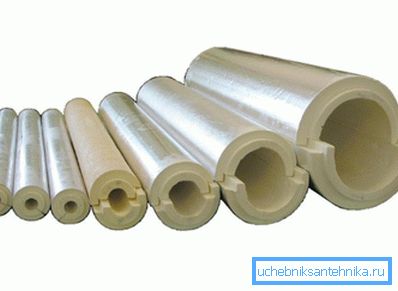
- We wrap the chimney with mats of basalt cotton wool, the thickness of which should be at least 5 cm. Wrap should be overlapped.
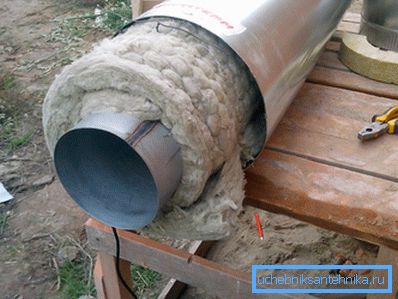
- We fasten insulation with several turns of steel wire.
- As a casing, sheet iron should be used, which is rolled along the diameter of the pipe with insulation and riveted at the junction of the edges.
Weathervanes and flyugarki
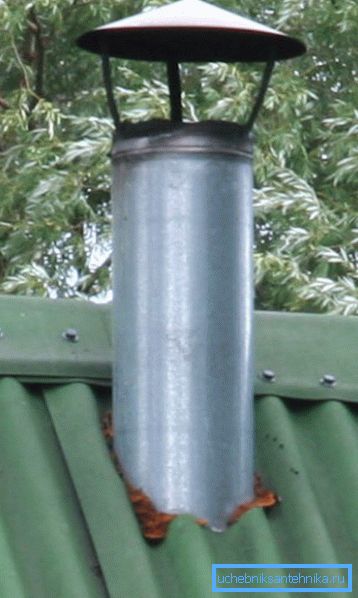
Nozzle on the chimney pipe in the form of vane and vane is not only a decorative element. This is the finishing touch of the finish, which protects the chimney from moisture and prevents the emergence of reverse thrust.
For reference: flugars on the chimney pipe is an ordinary cap, which can have several names: chimney cap, umbrella on the chimney pipe, chimney cap, etc.
The weather vane on the chimney pipe protects the pipe from precipitation, wind, and prevents the occurrence of reverse thrust, but it is the decoration of the roof and shows the direction of the wind. This is an old simple device that was originally used on ships. Now the rotating blades of the weather vane can be seen on the roofs of many houses.
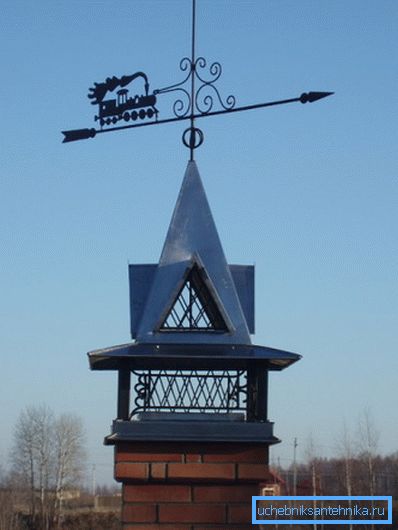
The simplest version of such nozzles is an umbrella on the chimney pipe. It is attached to the pipe with metal rivets or bolts.
Conclusion
As you can see, the process of isolation of the chimney is very important, and the work can be done independently. If you are building a fireplace or stove, then think about insulation in advance. This will not only protect the operation of the facility, but also increase the heat release. In the video in this article you can find more practical tips on this topic.